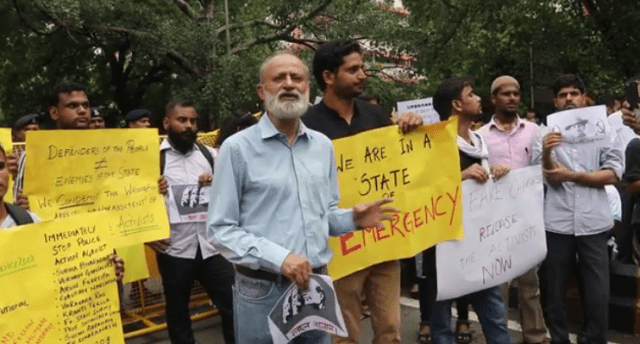News Analysis |
Indian police on Tuesday arrested five rights activists for suspected links to Maoist rebels in raids on their homes and offices in several places in the country. Police also accused the five of delivering speeches that triggered protests and violence between low-caste Dalits and right-wing groups near the western city of Pune in December.
The government says Maoist rebels, who are active in several states, are India’s biggest internal security threat. Those arrested Tuesday were Telugu-language poet Varavara Rao in Hyderabad, Vernon Gonzalves and Arun Farreira in Mumbai, and Gautam Navalakha and Sudha Bhardwaj in New Delhi and a neighboring town, the Press Trust of India news agency said.
The government crackdown was condemned by Aakar Patel, executive director of Amnesty International India, who said the arrests threatened core human rights values. “All these people have a history of working to protect the rights of some of India’s most poor and marginalized people. Their arrests raise disturbing questions about whether they are being targeted for their activism,” Patel said.
The narrative used by the Hindutva government in arresting Human right activists draws a parallel with those, which it uses against its rivals such as the leftist students at the JNU.
Amitabh Behar, CEO of Oxfam India, said the government should protect people’s rights to freedom of expression, association, and peaceful assembly instead of creating an atmosphere of fear. Congress President Rahul Gandhi on Tuesday took a dig at the center and said that in the “new India”, there was place for only one NGO – the Rashtriya Swayamsevak Sangh or the RSS, which is the ideological mentor of the BJP.
For many, the arrests evoke the June arrests of Dalit activists by terming them as Maoist sympathizers. The arrests were made as a part of a “joint operation” carried out by the Pune police along with its counterparts from Mumbai, Nagpur and Delhi. Contrary to earlier investigations, which focused on Manohar alias Sambhaji Bhide and Milind Ekbote, both Brahmins and prominent Hindutva leaders, the police now claim that “Naxals and their sympathizers” were behind the January 1 violence at Bhima Koregaon.
Read more: India’s forgotten Maoist insurgency in the red corridor
Naxalism is a radical communist ideology that views the Indian political system as an infected system of capitalism controlled by the bourgeoisie and analyses India as a semi-feudal country. Naxalism incorporates the principles of Stalinism and Maoism and believes that armed struggle and people’s revolution are the only way to ensure socialism and achieve the ultimate goal of communism. Since its beginning, Naxalism poses a great security threat to the dominance of New Delhi.
Police also accused the five of delivering speeches that triggered protests and violence between low-caste Dalits and right-wing groups near the western city of Pune in December.
The seeds of Naxalism ultimately got sown with the 1967 Naxalbari Uprising. CPI (M) leaders like Charu Mazumder, Kanu Sanyal and Jangal Santhal organized a peasant uprising in a village named Naxalbari, in the geographically strategic region of Siliguri Corridor. The uprising was a result of humiliation and torture faced by the peasants in Naxalbari and surrounding areas, which was meted out by the jotedars (landlords/zamindars) and their cronies and goons.
When cries of the impoverished peasants fell on deaf ears of the government, the peasants, with support of the radical communists, took matter into their own hands. They began an armed conflict with the jotedars, seized lands and confiscated food grains.
Read more: Dalit arrests show the abuse of Indian police system
This led to eruption of sporadic clashes across the area. The ruling United Front government dispatched state troops to control the situation which further intensified the movement. Innocent lives were taken on both sides. It is said that in the ruthless cordon and search operations conducted by the troops and police, hundreds were beaten and over a thousand were arrested.
Although the movement was suppressed, the spark of Naxalbari set aflame the fires of revolution in Srikakulam, Birbhum, Debra-Gopiballavpur, Mushahari and Lakhimpur-Kheri. The states of West Bengal, Andhra Pradesh, Bihar, Punjab, U.P and Tamil Nadu saw a big spurt in Naxalbari-inspired struggles and Maoist formations sprouted in nearly every state of India.
Naxalism is a radical communist ideology that views the Indian political system as an infected system of capitalism controlled by the bourgeoisie and analyses India as a semi-feudal country.
Today Naxals/Maoists operate across a “red corridor” stretching from the southern state of Andhra Pradesh to the central state of Chhattisgarh and into West Bengal, bordering Nepal and Bhutan. The government has called the rebels ‘India’s biggest internal security threat.’ With thousands of fighters, the rebels control vast swaths of an area in the country.
The rebels, also known as Naxalites, have ambushed police, destroyed government offices and abducted government officials for more than four decades. The insurgency began in 1967 as a network of left-wing ideologues and young recruits in the village of Naxalbari outside Kolkata, the capital of West Bengal state, came together.
Read more: India’s biggest internal threat strikes again
They have blown up train tracks, attacked prisons to free their comrades and stolen weapons from police and paramilitary warehouses to arm themselves. Last month, authorities said the troops killed at least 44 suspected rebels in multiple raids in western India. While the Naxals are a threat to the Indian State, many question the use of smokescreens to deal with dissidents under the BJP government of India.
The narrative used by the Hindutva government in arresting Human right activists draws a parallel with those, which it uses against its rivals such as the leftist students at the JNU. This is evident in the BJP’s strategy of depicting every rival as a threat to national security, an implicit supporter of Pakistan, backer of the Kashmiri liberation movement and having a soft corner for militants and Naxalites.














